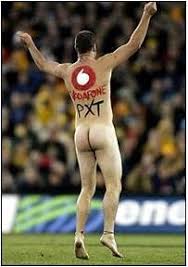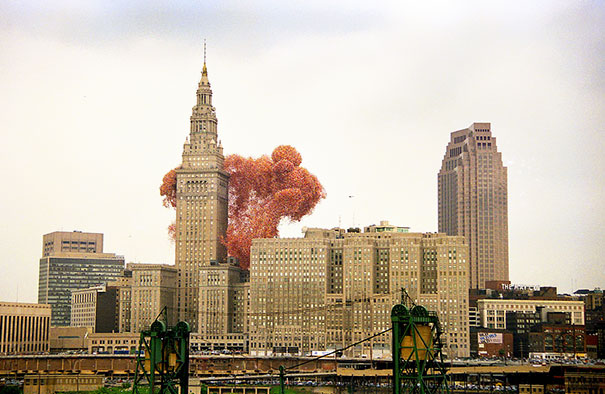"Anything that can go wrong will go wrong".
- Murphy’s Law
“Murphy was an optimist.”
- O’Toole’s Commentary
A few days ago I posted images of guerrilla marketing (marketing or promoting an event or product in public) and street marketing (guerrilla marketing that is confined to the streets), the essential characteristics being that such marketing is notable, memorable and different from more traditional print and media ads.
It prompted Byter Steve M to send me an email:
Super Bytes today Otto,I just love the street art/outdoor promotional ads. Brilliant! There are some pretty dreadful ads around at the moment so it is refreshing to see some genius at work in the advertising industry. Diane and I are just watching the series MadMen (about advertising)... well worth a squiz though it takes a few episodes to build.All the best as alwaysSteve m
But, to paraphrase Robbie Burns, the best laid plans of mice, men and guerrilla marketing often go awry, as the following incidences show:
Aqua Teen:
Aqua Teen Hunger Force, commonly known as Aqua Teen, is an American adult animated television series about the surreal adventures and antics of three anthropomorphic fast food items: Master Shake, Frylock and Meatwad. Also in the shows are The Mooninites, two pixelated, two-dimensional inhabitants of the Moon who frequently come to Earth.
In January 2007 the promoters of Aqua Teen Hunger Force Colon Movie Film for Theaters, a film based on Aqua Teen Hunger Force, thought it would be a great means of advertising the film by placing battery-powered LED placards depicting the Mooninites throughout Boston and the surrounding cities of Cambridge and Somerville.
The Boston Police Department and Boston Fire Department mistakenly identified the blinking placards as improvised explosive devices. With the population in heightened awareness in a post 9-11 world, installing a series of complex wire-filled devices with their own power sources on public structural elements like bridge supports was probably not the best of ides. Nor was not telling the police, even after learning that the devices were being treated as bombs.
The two men who placed the devices were arrested and Turner Broadcasting paid millions of dollars to city police and Homeland Security to resolve the matter.
A State Police Bomb Squad officer removes a device from a support column of the McGrath Highway on January 31, 2007.
A Mooninite hanging beneath an overpass in Boston.
Chicago Police commander Wayne Gulliford leans an electronic advertising devise against a wall
Vodafone:
Liverpool Football Club coach Bill Shankly has been famously quoted as saying “Some people believe football is a matter of life and death, I am very disappointed with that attitude. I can assure you it is much, much more important than that.'
Australians and New Zealanders who follow Rugby Union feel the same way about the Bledisloe Cup.
It should have been obvious beforehand that to interrupt a Bledisloe Cup match with a marketing stunt would not go down well.
In 2002 during the Bledisloe Cup match in Sydney, two men wearing nothing but the logo of phone company Vodafone painted on their bodies ran onto the field just as NZ All Black Andrew Mehrtens was preparing to take an important penalty kick. Mehrtens missed the kick and Australia went on to win 16-14.
It subsequently came out that the head of the Australian arm of Vodafone had okayed the stunt and agreed to pay any fines that the streakers might incur.
Vodafone ended up paying a host of fines due to the stunt. The streakers themselves were also fined for trespassing and indecent exposure.
Vodafone NZ managing director Tim Miles stated "Everyone here is very disappointed about what happened, and we want to apologise to the All Blacks, rugby fans, our customers and all of New Zealand, It was an inappropriate prank and if Vodafone New Zealand had known about it we would have put a stop to it." It also donated NZ$100,000 to a campaign to reduce sports injuries and published an apology in newspapers.
Balloonfest:
In 1985 Disneyland had set the world record when it released 1.2 million balloons to commemorate Disneyland's 30th anniversary. United Way of America (now United Way Worldwide), a nonprofit organisation that is a coalition of charitable organizations, decided to go bigger.
In Cleveland, Ohio, on September 27, 1986, in what was dubbed Balloonfest, almost 1.5 million balloons filled with helium were released at around 1:50 pm from the public square.
Even if the stunt had gone correctly, it would have still been a disaster. Today balloons are banned in most places, being dangerous to aircraft, environmentally unfriendly and dangerous to wildlife, especially marine wildlife when winds take the balloons over the seas and oceans.
But the stunt did not go correctly.
Rather than floating up and away, the balloons were caught in the airflow of an approaching rainstorm. Instead of rising and popping, they were wet by the rain and simply descended. They quickly drifted to the runway at a local airport, which temporarily shut down. Drivers swerved and crashed.
The balloons spooked prize-winning horses, whose owner settled with United Way for $100,000.
They also impeded the Coast Guard's attempts to locate a pair of boaters on Lake Erie, the surface of which was covered in balloons. The floating balloons made finding the head of someone fighting to stay above water impossible. The two men were later found to have drowned and their wives sued United Way. One settled for $3.2 million, another settled on undisclosed terms.
Snapple Popsicle:
Going bigger isn't always better, as Snapple found out in 2005 when it attempted to erect the world's largest popsicle in New York's Times Square.
The stunt might have worked had the drink maker not tried to set up the 7.62 metres (25foot) tall popsicle, made of frozen Snapple juice and weighing 16 tonnes (17.5 tons,) on an 80-degree June day. The frozen treat began to melt as it was being lifted upright, flooding parts of downtown Manhattan with kiwi-strawberry-flavoured Snapple.
Firefighters had to be called in to close off streets and hose down the mess.
Kids Who Could Fly:
Maximum Ride is a series about a group of children who can fly. To launch the latest book, the promoters created a large ground decal that showed Aucklanders what it was like to stand on the edge of a building and jump.
It was hammered for encouraging youth suicide.
What do you think?
Quite apart from the possible effect on young people, I feel queasy just looking at the pics.













No comments:
Post a Comment
Note: Only a member of this blog may post a comment.